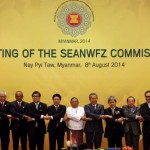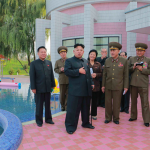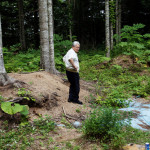- DETERRENCE: Can ASEAN Sell Its Nuclear Free Zone to the Nuclear Club?
- DPRK: A Conversation with Jang Il Hun (DPRK Ambassador)
- GOVERNANCE AND CIVIL SOCIETY: Japanese Village Grappling with Wartime Sins Comes Under Attack
- CLIMATE CHANGE ADAPTATION: Better Growth Better Climate: The New Climate Economy Report
- AUSTRAL PEACE AND SECURITY: “Here We Go Again”
 DETERRENCE: Can ASEAN Sell Its Nuclear Free Zone to the Nuclear Club? Catharin Dalpino, Sigur Center for Asian Studies, October 2014
DETERRENCE: Can ASEAN Sell Its Nuclear Free Zone to the Nuclear Club? Catharin Dalpino, Sigur Center for Asian Studies, October 2014
Myanmar’s President Thein Sein will try at the November East Asia Summit to move the P5 to ratify the nuclear weapons states’ (NWS) protocols to the SEA-NWFZ treaty. The P5 NWS may accede to the SEA-NWFZ to secure a “21st century vehicle for counter-terrorism cooperation.” Dialogue on Middle-East WMD and NEA-NWF Zones continues.
- Time to strike a comprehensive security deal in Northeast Asia, Morton Halperin, The Asahi Shimbun, September 11, 2014
- Mideast Nuclear Weapons-Free Zone Remains in Limbo, Inter Press Service News Agency, September 11, 2014
- Iranian leader says Middle East needs to become weapons-free zone, ITAR-TASS, September 16, 2014
 DPRK: A Conversation with Jang Il Hun (DPRK Ambassador). Council on Foreign Relations. (20 October 2014). [Video, 1:04:35, transcript available]
DPRK: A Conversation with Jang Il Hun (DPRK Ambassador). Council on Foreign Relations. (20 October 2014). [Video, 1:04:35, transcript available]
The issue of human rights is generally “formless” in the Sun Tzu sense of that term and therefore mostly unresponsive to threats or military force; North Korea’s recent diplomatic surge may be a reaction to what it sees as an asymmetric threat of human rights to attack its Supreme Leader. North Korea’s threats to pull out of talks with South Korea are a common tactic to stall for time, conditions or both. North Korea’s multi-spectrum threats especially IF (big if) it has miniaturized a nuclear warhead, ironically, strongly justify US forces in Korea and even increase the likelihood of deploying some sort of Theater Missile Defense which negatively impacts China’s perceived security.
- Fearing North Korean fire, farmers clash with activists. Sam Kim, Bloomberg. (26 October 2014)
- U.S. Commander sees key nuclear step by North Korea. David E. Sanger, New York Times. (24 October 2014)
 GOVERNANCE AND CIVIL SOCIETY: Japanese Village Grappling with Wartime Sins Comes Under Attack, Martin Fackler, New York Times (28 October 2014)
GOVERNANCE AND CIVIL SOCIETY: Japanese Village Grappling with Wartime Sins Comes Under Attack, Martin Fackler, New York Times (28 October 2014)
A group of conservative Japanese citizens online, known as the “Net Right”, are emerging with greater sway and anti-Korean sentiment, accusing cities with monuments to Korean laborers as treasonous. While these groups constitute a minority, they seem to be gaining a larger voice, with a heated public debate held between the Osaka mayor and the leader of an anti-Korean group.
- ‘Hate speech’ debate turns ugly between Osaka mayor, anti-Korean leader, Yuichi Inoue, Asahi Shimbun (21 October 2014)
- Suga: Kono’s 1993 remarks on ‘comfort women’ cause ‘major problem’, Asahi Shimbun (22 October 2014)
 CLIMATE CHANGE ADAPTATION: Better Growth Better Climate: The New Climate Economy Report, Global Commission on the Economy and Climate (September 2014) [3.44 MB, PDF]
CLIMATE CHANGE ADAPTATION: Better Growth Better Climate: The New Climate Economy Report, Global Commission on the Economy and Climate (September 2014) [3.44 MB, PDF]
A major assessment (commissioned by governments of seven countries including: Colombia, Ethiopia, Indonesia, Norway, South Korea, Sweden and the United Kingdom) considered how best to achieve prosperity and development at the same time as reducing carbon emissions and adapting to the impacts of climate change. There is the opportunity for all economies, regardless of current economic status, to grow while still moving to a low-carbon and climate adapted future.
- Seeing is Believing: Creating a New Climate Economy in the United States, Working Paper, Nicholas Bianco et al., World Resources Institute and the Global Commission on the Economy and Climate (October 2014) [3.54 MB, PDF]
- Global Warming: Improve Economic Models of Climate Change, Richard L. Revesz et al., Nature News & Comment (2014) [2.09 MB, PDF]
 AUSTRAL PEACE AND SECURITY: “Here We Go Again”, Paul Barratt, Arena Magazine 133, October 2014
AUSTRAL PEACE AND SECURITY: “Here We Go Again”, Paul Barratt, Arena Magazine 133, October 2014
Barratt: “Australia is once more embarked upon a military adventure in the Middle East, again at the behest of the United States, and again without a clear aim.” Cordesman: “The basic goal of degrading and destroying the Islamic State always bordered on the ridiculous.” (Australian) Defence Operations – Iraq : “Further information about the international effort to combat the ISIL terrorist threat in Iraq can be found at the U.S. Department of Defense website.”
- The imploding U.S. strategy in the Islamic State war? Anthony H. Cordesman, CSIS (23 October 2014)
- Operation OKRA, Department of Defence (Australia)
- The language and actions of states and non-states: unspeakable crimes, indefensible actions, always in a ‘good cause’, Lily Hamourtziadou, Iraq Body Count (16 October 2014)
The Nautilus Peace and Security Weekly Report presents articles and full length reports each week in six categories: Austral security, nuclear deterrence, energy security, climate change and security, the DPRK, climate change adaptation and governance and civil society. Our team of contributors carefully select items that highlight the links between these themes and the three regions in which our offices are found—North America, Northeast Asia, and the Austral-Asia region.
- Subscribe to NAPSNet to receive free weekly email reports.
- Reports Editor: Frederica Kreitzer
Contributors:
- Deterrence: Peter Hayes
- DPRK: Roger Cavazos
- Governance and Civil Society: Dyana Mardon
- Energy Security: Nikhil Desai
- Climate Change Adaptation: Saleem Janjua
- Austral Peace and Security: Richard Tanter

